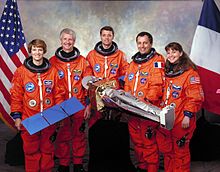
Back STS-93 Arabic STS-93 Bulgarian STS-93 Catalan STS-93 Czech STS-93 Danish STS-93 German STS-93 Spanish STS-93 Estonian استیاس-۹۳ Persian STS-93 French
 Chandra and its Inertial Upper Stage, prior to deployment from Columbia's payload bay | |
| Names | Space Transportation System-93 |
|---|---|
| Mission type | Chandra X-ray Observatory Deployment |
| Operator | NASA |
| COSPAR ID | 1999-040A |
| SATCAT no. | 25866 |
| Mission duration | 4 days, 22 hours, 49 minutes, 34 seconds |
| Distance travelled | 2,890,000 km (1,796,000 mi)[1] |
| Orbits completed | 80 |
| Spacecraft properties | |
| Spacecraft | Space Shuttle Columbia |
| Launch mass | 122,534 kg (270,142 lb)[2] |
| Landing mass | 99,781 kg (219,980 lb)[2] |
| Payload mass | 22,780 kg (50,222 lb)[2] |
| Crew | |
| Crew size | 5 |
| Members | |
| Start of mission | |
| Launch date | 23 July 1999, 04:31:00 UTC[3] |
| Launch site | Kennedy LC-39B |
| End of mission | |
| Landing date | 28 July 1999, 03:20:35 UTC[3] |
| Landing site | Kennedy SLF Runway 33 |
| Orbital parameters | |
| Reference system | Geocentric |
| Regime | Low Earth |
| Perigee altitude | 260 kilometres (160 mi) |
| Apogee altitude | 280 kilometres (170 mi) |
| Inclination | 28.4 degrees |
| Period | 90 minutes |

 Left to right: Collins, Hawley, Ashby, Tognini, Coleman | |
STS-93 in 1999 marked the 95th launch of the Space Shuttle, the 26th launch of Columbia, and the 21st night launch of a Space Shuttle. Eileen Collins became the first female shuttle Commander on this flight. Its primary payload was the Chandra X-ray Observatory.
STS-93 would be Columbia's last mission until March 2002. During the interim, Columbia would be out of service for upgrading and would only fly again on STS-109. The launch was originally scheduled for 20 July, but it was aborted at T−7 seconds.[4]: 221 The successful launch of the flight occurred three days later. The payload was also the heaviest ever carried by the Space Shuttle system, at over 22.7 tonnes (25 tons).[5][6]
- ^ "STS-93 (95)". Shuttle Countdown Online. NASA. Archived from the original on 2 July 2019. Retrieved 29 April 2018.
- ^ a b c "STS-93: Columbia OV102". Shuttle Press Kit. 13 July 1999. Retrieved 29 April 2018.
- ^ a b "International Flight No. 210: STS-93". Spacefacts.de. Retrieved 29 April 2018.
- ^ Collins, Eileen M.; Ward, Jonathan H. (2021). Through the Glass Ceiling to the Stars: The Story of the First American Woman to Command a Space Mission. New York: Arcade. ISBN 978-1-950994-05-2. OCLC 1281565457.
- ^ "Shuttle releases heaviest payload ever". CNN. 23 July 1999. Retrieved 28 August 2018.
- ^ "Heaviest payload launched - shuttle". Guinness World Records. July 1999. Retrieved 28 August 2018.
© MMXXIII Rich X Search. We shall prevail. All rights reserved. Rich X Search